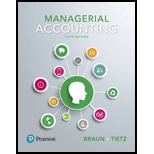
Prepare income statements using variable costing and absorption costing with changing inventory levels (Learning Objective 6)
Hadlock Manufacturing manufactures a single product that it will sell for $68 per unit. The company is looking to project its operating income for its first two years of operations. Cost information for the single unit of its product is as follows:
- Direct material per unit produced $30
- Direct labor cost per unit produced $11
- Variable manufacturing
overhead (MOH) per unit produced $5 - Variable operating expenses per unit sold $3
- Fixed manufacturing overhead (MOH for each year is $176,000, while fixed operating expenses for each year will be $86,000.
During its first year of operations, the company plans to manufacture 22,000 units and anticipates selling 16,000 of those units. During the second year of its operations, the company plans to manufacture 22,000 units and anticipates selling 24,000 units (it has units in beginning inventory for the second year from its first year of operations).
Requirements
- 1. Prepare an absorption costing income statement for the following:
- a. The first year of operations
- b. The second year of operations
- 2. Before you prepare the variable costing income statements for Hadlock, predict the company’s operating income using variable costing for both its first year and its second year without preparing the variable costing income statements. Hint: Calculate the variable costing operating income for a given year by taking that year’s absorption costing operating income and adding or subtracting the difference in operating income as calculated using the following formula: Difference in operating income = (Change in inventory level in units × Fixed MOH per unit)
- 3. Prepare a variable costing income statement for each of the following years:
- a. The first year of operations
- b. The second year of operations
Want to see the full answer?
Check out a sample textbook solution
Chapter 6 Solutions
Managerial Accounting (5th Edition)
- Nonearrow_forwardWhat is Hannah's debt to equity ratio???arrow_forwardQuestion 1. Pearl Leasing Company agrees to lease equipment to Martinez Corporation on January 1, 2025. The following information relates to the lease agreement. 1. The term of the lease is 7 years with no renewal option, and the machinery has an estimated economic life of 9 years. 2 The cost of the machinery is $541,000, and the fair value of the asset on January 1, 2025, is $760,000. 3. At the end of the lease term, the asset reverts to the lessor and has a guaranteed residual value of $45,000, Martinez estimates that the expected residual value at the end of the lease term will be $45,000. Martinez amortizes all of its leased equipment on a straight-line basis. 4. The lease agreement requires equal annual rental payments, beginning on January 1, 2025. 5. The collectibility of the lease payments is probable. 6. Pearl desires a 10% rate of return on its investments. Martinez's incremental borrowing rate is 11%, and the lessor's implicit rate is unknown. Annual rental payment is…arrow_forward
 Cornerstones of Cost Management (Cornerstones Ser...AccountingISBN:9781305970663Author:Don R. Hansen, Maryanne M. MowenPublisher:Cengage Learning
Cornerstones of Cost Management (Cornerstones Ser...AccountingISBN:9781305970663Author:Don R. Hansen, Maryanne M. MowenPublisher:Cengage Learning Essentials of Business Analytics (MindTap Course ...StatisticsISBN:9781305627734Author:Jeffrey D. Camm, James J. Cochran, Michael J. Fry, Jeffrey W. Ohlmann, David R. AndersonPublisher:Cengage Learning
Essentials of Business Analytics (MindTap Course ...StatisticsISBN:9781305627734Author:Jeffrey D. Camm, James J. Cochran, Michael J. Fry, Jeffrey W. Ohlmann, David R. AndersonPublisher:Cengage Learning Managerial Accounting: The Cornerstone of Busines...AccountingISBN:9781337115773Author:Maryanne M. Mowen, Don R. Hansen, Dan L. HeitgerPublisher:Cengage Learning
Managerial Accounting: The Cornerstone of Busines...AccountingISBN:9781337115773Author:Maryanne M. Mowen, Don R. Hansen, Dan L. HeitgerPublisher:Cengage Learning Managerial AccountingAccountingISBN:9781337912020Author:Carl Warren, Ph.d. Cma William B. TaylerPublisher:South-Western College Pub
Managerial AccountingAccountingISBN:9781337912020Author:Carl Warren, Ph.d. Cma William B. TaylerPublisher:South-Western College Pub Excel Applications for Accounting PrinciplesAccountingISBN:9781111581565Author:Gaylord N. SmithPublisher:Cengage Learning
Excel Applications for Accounting PrinciplesAccountingISBN:9781111581565Author:Gaylord N. SmithPublisher:Cengage Learning




